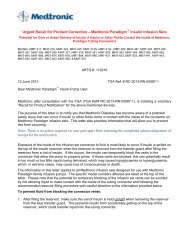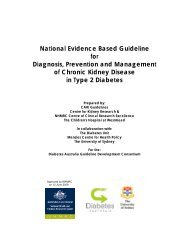Background - <strong>Foot</strong> Cl<strong>in</strong>ics <strong>and</strong> Multi-discipl<strong>in</strong>ary TeamsRecommendations to prevent amputation <strong>in</strong> people with diabetes <strong>and</strong> high risk feet<strong>in</strong>clude regular foot exam<strong>in</strong>ation, education, suitable footwear <strong>and</strong> orthotics, podiatryservices, <strong>and</strong> early ulcer treatment <strong>in</strong>clud<strong>in</strong>g surgery where <strong>in</strong>dicated (Mason et al,1999). Implementation <strong>of</strong> these recommendations cannot be achieved easily by onecategory <strong>of</strong> health provider <strong>and</strong> are best achieved with a multi-discipl<strong>in</strong>ary teamapproach. Provid<strong>in</strong>g this recommended care requires the services <strong>of</strong> a physician,podiatrist, diabetes educator <strong>and</strong> vascular or orthopaedic surgeon (Bild et al, 1989).Unfortunately multi-discipl<strong>in</strong>ary diabetes foot cl<strong>in</strong>ics are not common <strong>in</strong> Australia<strong>and</strong> most people receive their care <strong>in</strong> different sites <strong>and</strong> some have geographicaldifficulty <strong>in</strong> access<strong>in</strong>g a complete range <strong>of</strong> services.Because <strong>of</strong> cost implications <strong>and</strong> geographic considerations it is important to evaluatewhether a multi-discipl<strong>in</strong>ary team approach can reduce amputation <strong>in</strong> high riskpeople. Even if this can be demonstrated, the provision <strong>of</strong> such services will stillrema<strong>in</strong> a challenge <strong>in</strong> many parts <strong>of</strong> Australia.Evidence - <strong>Foot</strong> Cl<strong>in</strong>ics <strong>and</strong> Multi-discipl<strong>in</strong>ary TeamsA multi-discipl<strong>in</strong>ary specialist footcare team can reduce ulceration <strong>and</strong>amputation <strong>in</strong> people with high risk feetThe studies identified are difficult to compare because there is no universal def<strong>in</strong>ition<strong>of</strong> multi-discipl<strong>in</strong>ary care <strong>and</strong> the sett<strong>in</strong>gs <strong>in</strong> which such care is <strong>of</strong>fered vary fromprimary care to hospital specialist referral cl<strong>in</strong>ics. Studies have been eitherretrospective or prospective cohort studies <strong>and</strong> true r<strong>and</strong>omisation <strong>of</strong> high risksubjects to rout<strong>in</strong>e care or specialised cl<strong>in</strong>ic is virtually impossible <strong>and</strong> probablyunethical.In Manchester, UK, a weekly diabetic foot cl<strong>in</strong>ic with a multi-discipl<strong>in</strong>ary team wasestablished at the district hospital to which people with diabetes <strong>and</strong> foot lesions werereferred from a wide range <strong>of</strong> sources (Thomson et al, 1991). The diabetic foot cl<strong>in</strong>icwas staffed by a diabetologist, chiropodist, specialist foot nurse <strong>and</strong> orthotist. Subjectswere discharged from the cl<strong>in</strong>ic once adequate provision for follow up podiatry carehad been made. Of 260 subjects who were referred to the cl<strong>in</strong>ic, 112 (73%) had <strong>Type</strong>2 diabetes, <strong>and</strong> 153 (59%) had a new foot ulcer. Ulcer heal<strong>in</strong>g was obta<strong>in</strong>ed <strong>in</strong> 96cases among 119 subjects available for follow-up. The annual amputations <strong>in</strong> peoplewith diabetes <strong>in</strong> the subsequent 3 years were reduced by 42% compared to prior years(Thomson et al, 1991).A predom<strong>in</strong>antly descriptive report from Italy detailed the effects <strong>of</strong> sett<strong>in</strong>g up <strong>of</strong> amulti-discipl<strong>in</strong>ary hospital foot cl<strong>in</strong>ic which provided <strong>in</strong>tensive management <strong>of</strong> ulcerswith patient education, surgery <strong>and</strong> detailed follow up <strong>of</strong> foot lesions (Ghirl<strong>and</strong>a et al,1997). People attend<strong>in</strong>g the cl<strong>in</strong>ic had underly<strong>in</strong>g neuropathy <strong>and</strong> presented withplantar ulcers (66%), s<strong>of</strong>t tissue <strong>in</strong>fections (30%), necrosis <strong>of</strong> at least one toe (24%)<strong>and</strong> osteomyelitis (10%). In the 250 people evaluated over the <strong>in</strong>itial 3-year period, noamputation were performed. 98% <strong>of</strong> people with neuropathy had heal<strong>in</strong>g <strong>of</strong> their84
lesion, 10% had ulcer recurrence at the primary site, 4% at a different site <strong>and</strong> 5% hadosteomyelitis at other locations (Ghirl<strong>and</strong>a et al, 1997).A Swedish retrospective study reported the changes <strong>in</strong> diabetes related amputationfollow<strong>in</strong>g the implementation <strong>in</strong> 1983 <strong>of</strong> a multi-discipl<strong>in</strong>ary footcare teamprogramme for prevention <strong>and</strong> treatment <strong>of</strong> diabetic foot ulcers (Larsson et al, 1995).The team consisted <strong>of</strong> a diabetologist, orthopaedic surgeon, diabetes nurse, podiatrist<strong>and</strong> orthotist. From 1982 to 1993, 294 people with diabetes (mean age 77 years) had387 major (above the ankle) or m<strong>in</strong>or (through or below ankle) amputations whichrepresented 48% <strong>of</strong> all lower extremity amputations. Dur<strong>in</strong>g this period the annualnumber <strong>of</strong> amputations at all levels decreased from 38 to 21, equall<strong>in</strong>g a decrease <strong>in</strong><strong>in</strong>cidence from 19.1 to 9.4/100,000 people (p=0.001); <strong>and</strong> the <strong>in</strong>cidence <strong>of</strong> majoramputations decreased by 78% from 16 to 3.6/100,000 <strong>in</strong>habitants (p
- Page 1:
National Evidence Based Guidelinesf
- Page 4:
Research OfficersMs Linda SmithPodi
- Page 7 and 8:
2.2 Issues for Foot Problems in Typ
- Page 9:
• Aim to achieve the best possibl
- Page 12 and 13:
Background - Peripheral Neuropathy
- Page 14 and 15:
proportion of subjects with a durat
- Page 16 and 17:
and an OR 1.1-7.8. This study also
- Page 18 and 19:
Summary - Peripheral Neuropathy as
- Page 20 and 21:
Section 2: Diabetes Foot ProblemsIs
- Page 22 and 23:
predicting risk of amputation, 2.9
- Page 24 and 25:
Summary - Peripheral Vascular Disea
- Page 26 and 27:
Section 3: Diabetes Foot ProblemsIs
- Page 28 and 29:
Evidence - Foot Deformity and Previ
- Page 30 and 31:
people with both LJM and neuropathy
- Page 32 and 33:
Summary - Foot Deformity and Previo
- Page 34 and 35: Section 4: Diabetes Foot ProblemsIs
- Page 36 and 37: Also in the Seattle study, 67 peopl
- Page 38 and 39: Summary - Ulcer as a Risk Factor fo
- Page 40 and 41: Section 5: Diabetes Foot ProblemsIs
- Page 42 and 43: The other frequently reported metho
- Page 44 and 45: side; and 82% having the same resul
- Page 46 and 47: Evidence Table: Section 5Detection
- Page 48 and 49: Background - Clinical Detection of
- Page 50 and 51: pulse was bilaterally absent in 1.8
- Page 52 and 53: Evidence Table: Section 6AuthorClin
- Page 54 and 55: Background - Frequency of Foot Exam
- Page 56 and 57: Summary - Frequency of Foot Examina
- Page 58 and 59: Section 8: Diabetes Foot ProblemsIs
- Page 60 and 61: Behaviour assessment scores, measur
- Page 62 and 63: Mazzuca et al (1986) studies 532 pe
- Page 64 and 65: with before the programme, after 1-
- Page 66 and 67: Evidence Table: Section 8AuthorEffe
- Page 68 and 69: Background - Glycaemic Control and
- Page 70 and 71: In a previous Japanese randomised s
- Page 72 and 73: Evidence Table: Section 9AuthorGlyc
- Page 74 and 75: Background - Footwear to Reduce Ulc
- Page 76 and 77: period. In addition people without
- Page 78 and 79: Comparisons of in-shoe foot pressur
- Page 80 and 81: The rate of plantar callus formatio
- Page 82 and 83: Evidence Table: Section 10AuthorFoo
- Page 86 and 87: A prospective non randomised contro
- Page 88 and 89: Summary - Foot Clinics and Multi-di
- Page 90 and 91: Section 12: Diabetes Foot ProblemsI
- Page 92 and 93: and/or osteomyelitis; III - fore-fo
- Page 94 and 95: Summary - Economic consequences•
- Page 96 and 97: Section 13: Diabetes Foot ProblemsI
- Page 98 and 99: Some ethnic groups are associated w
- Page 100 and 101: Evidence Table: Section 13AuthorSoc
- Page 102 and 103: Calle-Pascual AL, Duran A, Diaz A,
- Page 104 and 105: Jannink MJ, van Dijk H, de Vries J,
- Page 106 and 107: Moss SE, Klein R, Klein BE. The 14-
- Page 108 and 109: Soulier SM, Godsey C, Asay ED, Perr
- Page 110 and 111: Diabetes Foot Problems: General Ref
- Page 112 and 113: McNeely MJ, Boyko EJ, Ahroni JH, St
- Page 114 and 115: Diabetes Foot Problems: Other Refer
- Page 116 and 117: Caputo GM, Cavanagh PR, Ulbrecht JS
- Page 118 and 119: Garbalosa JC, Cavanagh PR, Wu G, Ul
- Page 120 and 121: Lavery LA, Armstrong DG, Wunderlich
- Page 122 and 123: Payne C. Regional variations of dia
- Page 124 and 125: Tovi J, Svanborg E, Nilsson BY, Eng
- Page 126 and 127: Criteria used to determine the suit
- Page 128 and 129: QUESTIONS KEY WORDS NO.ARTICLESIDEN
- Page 130 and 131: QUESTIONS KEY WORDS NO.ARTICLESIDEN
- Page 132 and 133: QUESTIONS KEY WORDS NO.ARTICLESIDEN
- Page 134 and 135:
QUESTIONS KEY WORDS NO.ARTICLESIDEN
- Page 136 and 137:
QUESTIONS KEY WORDS NO.ARTICLESIDEN
- Page 138 and 139:
QUESTIONS KEY WORDS NO.ARTICLESIDEN
















